Do you need a tooth filling, or are you putting off getting one because you’re nervous about it? Nobody loves visiting the dentist, but fillings are a very common restorative dental procedure to help prolong the life of your teeth.
Do fillings hurt? Many people worry about tooth filling pain, but thanks to modern dentistry techniques the procedure is usually pain-free. You may experience some sensitivity after a filling but there are ways to reduce any discomfort. Below you can read more about how fillings are done, how long they take, and what precautions you should take after getting a filling.
We also explain the different types of fillings, the materials dentists use, how much an NHS filling costs, and what you can expect to pay with a private dentist.
We hope this guide answers all your questions about dental fillings and prepares you for your next trip to the dentist.
In This Article
What is a filling?
A tooth filling is a type of dental restoration which repairs damage caused by tooth decay and prolongs the life of the tooth.
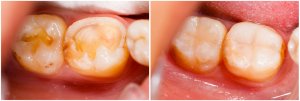
Fillings are a very common dental procedure – as many as 80% of adults end up with at least one filling during their lifetimes, and most people have several. In the year 2017-2018, NHS dentists in England performed over 10.2 million filling treatments for adults and 3.3 million for children, according to NHS statistics. 24% of adult treatment courses included fillings during this time.
To treat a tooth with dental caries (tooth decay) in this way, a dentist first drills out all the decayed material and cleans the cavity. They then fill the hole in the tooth with one of a number of filling materials.
Once the filling is complete, the tooth can function as normal for many more years.
If left untreated, tooth decay will continue to erode the tooth, leading to cavity pain. An abscess may eventually form somewhere around the tooth, requiring more drastic treatment like root canal work or even an extraction.
You may not relish the idea of having a filling, but it’s really the best way to stop decay in its tracks and preserve the tooth for as long as possible.
Types of tooth fillings – what are dental fillings made of?
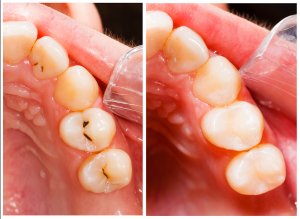
There are various different tooth filling materials that dentists use according to the type of filling. For a front tooth filling, for instance, dentists typically use a tooth-coloured material. Many of these dental adhesives are the same as those used to attach crowns, bridges and veneers.
Each material has its own benefits and drawbacks in terms of:
- Cost
- Appearance
- Strength
- Durability
- Ease of application
Below you can read about the main differences between the most common tooth filling materials.
Amalgam (silver) fillings
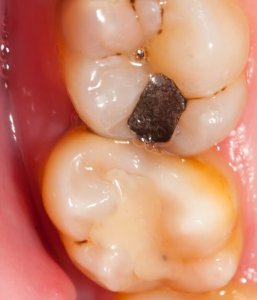
Silver-coloured amalgam fillings are made from a mixture of metals; around 50% mercury along with silver, tin and copper.
This is the cheapest tooth filling material available and is relatively easy to apply. It’s also the strongest, which is why it’s often used on stress-bearing surfaces. It’s a particularly good option for large or deep fillings.
One obvious downside is the aesthetics; metal fillings are unsightly and so are usually avoided for front teeth. Some people also prefer to avoid amalgam fillings because of concerns about their mercury content. Although some mercury vapour can be released while placing or removing these fillings, the NHS states that “there is no evidence that exposure to mercury from amalgam fillings has any harmful effects on health”. The American FDA concurs that dental amalgam is safe to use in adults and children over 6.
Do you want to read more about the potential risks of dental amalgam, the clinical studies into its use, and whether you should choose amalgam or composite fillings? We explore all of this in more detail in our article exploring composite vs. amalgam fillings.
Composite resin fillings
Composite tooth fillings are typically made from a mixture of acrylic resin and powdered glass. The composite material is shaded to match your natural tooth colour as closely as possible, making the filling hardly noticeable.
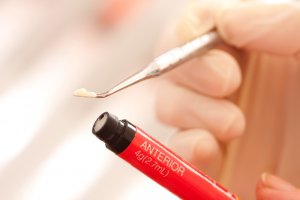
However, this dental filling material isn’t quite as durable as amalgam. It therefore may not be recommended for deep fillings and those on biting surfaces. It is also more technically difficult to apply, meaning the process takes a little longer.
Other uses of composite material include aesthetic dental veneers and chipped tooth repair.
Glass ionomer fillings
Glass ionomer cement is another white tooth filling option. It’s not as strong as composite resin, so its use is often limited to temporary fillings, such as in children’s milk teeth. It may also be used to fill decayed areas on teeth roots below the gum line, since it doesn’t have to bond to a dry surface.
Glass ionomer has the added benefit of releasing fluoride, which helps prevent further decay.
Gold fillings
Gold fillings are also an option, but their distinctive look means they are not everyone’s first choice. They are very strong, and the most durable of all these filling materials, but also the most expensive.
Gold fillings can’t be applied and shaped directly into the tooth cavity. Instead, they are usually made in a lab based on an impression of the tooth. This means more time in the dentist’s chair – something that many people are keen to avoid.
There is one type of filling we’re not going to cover in this article: root fillings. Read more about root canal work.
Comparison of dental filling materials
The table below summarises the key properties of each of these types of tooth filling:
Amalgam | Composite Resin | Glass Ionomer | Gold | |
Colour | Silver | Tooth-coloured | Tooth-coloured | Gold |
Durability | Strong; lasts 10-15 years | Good; lasts 5-10 years | Fair; lasts up to 5 years | Strong; lasts 15+ years |
Cost | Low | Medium | Medium | High |
Available on NHS? | Yes | Yes, usually for front teeth | Yes, usually for milk teeth | No |
Pros | Affordable, strong for biting surfaces | Good aesthetics, suitable for small fillings | Good aesthetics, releases fluoride | Very strong and durable |
Cons | Unattractive, some concerns about mercury | Can't take excessive force | Fractures and wears away easily | Expensive, conspicuous, longer procedure |
Temporary tooth filling kits
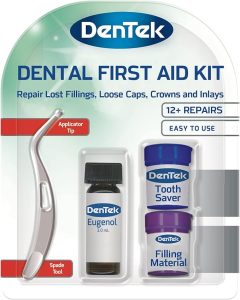
Are you wondering about doing a DIY tooth filling? You can buy temporary tooth filling kits online and in high street chemists, but are they safe to use?
Well, using a DIY tooth filling kit is fine as a temporary measure while you wait to see a dentist. Kits like this one from Dentek contain the same materials that dentists use, and can help reduce pain and avoid further damage to your teeth before you get a proper filling put in.
But – we cannot stress this enough – they are not a long-term fix. The material isn’t designed to last more than a few days, and you risk further damage to your tooth if you don’t get professional treatment. Plus, if you have underlying tooth decay that isn’t treated, you may eventually develop a painful dental abscess and need much more drastic treatment.
Dental tooth filling procedure
Do you want to know what happens when you get a dental filling? The procedure varies slightly according to the type of filling, but here are the main steps that dentists follow:
Step 1: Checkup

When you go for a dental checkup, your dentist will use a small mirror to inspect every surface of each tooth. They will check for signs of decay as well as any cracks or fissures that might be susceptible to decay in the future, and will advise you if you have any teeth that need fillings or other treatment. They might also take a dental x-ray to get a better idea of the condition of your teeth.
Of course, you may already know that you need a filling. Perhaps you’ve noticed a small cavity in your tooth, have been experiencing tooth pain or sensitivity, or an old filling has come out.
Step 2: Anaesthetic
If the decay is only on the surface of the tooth, the dentist may not need to administer an anaesthetic at all. They can drill the damaged tooth enamel without it causing any pain.
In most cases, however, the dentist will inject a local anaesthetic to numb the area around the tooth. They might also use a numbing gel on the gum to minimise discomfort from the injection itself.
Step 3: Removing decay

After the anaesthetic has taken effect, the dentist will remove any parts of the tooth damaged from decay. This is done using a high-speed dentist’s drill, air abrasion tool, or laser.
This is the least pleasant part of the process for many people, but thanks to the anaesthetic, it shouldn’t hurt. You’ll just feel the vibrations and pressure from the drill and other tools. It can sound quite loud, especially with teeth on your upper jaw, but it’s fine for you to take some music to listen to on headphones if you want to take your mind off this.
Once the tooth is free from decay, the dentist will make sure the hole is a suitable size and shape to hold the filling material firmly in place. They will also make sure it’s completely clean and sterile, ready for the filling material to be applied.
Step 4: Filling
For an amalgam filling, the material is mixed immediately before application. The dentist presses it into the space to be filled, and it soon hardens by itself.
With a direct composite filling, the surface will first be etched with an acid gel to make the bond stronger. After around 15 seconds, the gel is washed off leaving a roughened surface behind. Next, the dentist applies a thin layer of bonding agent to the surface about to be filled. This foundational layer helps the composite material form a strong bond with the tooth. Note that some manufacturers now combine these two steps into a single product which doesn’t need to be washed off.

The bonding agent and composite filling material must be cured with a blue light to harden them. Depending on how deep the filling is, the dentist may build the dental composite up in stages, hardening one layer at a time. It has a putty-like consistency before it’s cured, so the dentist can press it right into the cavity and mould it to the correct shape.
If you’re getting an indirect gold or porcelain filling, the process differs at this stage. The dentist will take a mould or impression of your tooth which is sent away to a lab. You’ll get a temporary filling and will need to come back several days later, once your permanent filling has been made, to complete the process.
Step 5: Shaping and polishing
Once the dental filling is in place and the material has hardened, it’s time to refine the shape and polish it. The dentist will shape it to match the original tooth as closely as possible.
If the filling is on a biting surface, they will use a piece of articulating paper to check that it’s a good fit. You’ll be asked to bite down on a thin strip of paper, which leaves marks on your teeth to show the dentist how the new filling is making contact with your other teeth. They may make small refinements to improve the biting contact, before giving the tooth a final buff and polish.
The video below shows how a tooth with dental caries is prepared and filled with white composite material. (Note that it skips the parts where the composite material is cured with a blue light.)
How long does a filling take?
As you can see, there are many variables which affect how long it takes to get a filling. Amalgam placement is quicker than composite; deep fillings take longer than shallow ones; and skipping anaesthetic of course speeds up the process.
Most fillings take between 20 minutes and one hour from start to finish. Dentists can perform two or more fillings in a single visit, provided they are not too complex.
Ask your dentist how long your filling is likely to take so you know what to expect. If you’re feeling nervous, it might help to have your dentist explain each part of the process as they’re doing it. They may also be able to offer you dental sedation to help with your anxiety.
Do fillings hurt?

One of the most common questions people have on this topic is “Does getting a filling hurt?“. It’s quite natural to be worried about pain during and after a filling. Rest assured that modern anaesthetic techniques mean the area around the tooth is completely numb during the procedure.
The injection itself can be slightly painful; you might feel a pinching or stinging sensation for a few seconds but then it’s done. Dentists can reduce this discomfort by using a numbing gel on the gum before administering the injection.
It’s possible to complete small cavity fillings without an injection if the decay is only on the surface of the tooth. Trust your dentist’s advice – they know which types of fillings will require anaesthetic and which won’t.
In the video below, a vlogger called Roxanne describes her first visit to the dentist for fillings – while her anaesthetic is still wearing off! She explains that:
- She needed four injections but she didn’t feel any pain, just a bit of pressure.
- The drilling took under a minute, which was less than she expected.
- She has to go back for a second filling in a few weeks but she isn’t worried about it at all.
Tooth pain after a filling
Once your anaesthetic wears off, you shouldn’t experience any pain from the tooth itself. The injection site may be a little sore for a day or two, though.
If you do find your tooth hurts after a filling, there may be a problem that your dentist needs to fix. For instance, the filling may have cracked or moved out of place, exposing the tooth nerves underneath. If it’s painful when you bite, it may have been placed too high and will need to be polished down a little more.

It’s possible for the dental pulp inside the tooth to become inflamed – a condition known as pulpitis – usually as a result of some decayed material being left behind during the filling procedure. Pulpitis can sometimes heal by itself, otherwise, root canal treatment will be needed to fully remove the infected tissue.
In some rare cases, people experience allergies to certain dental filling materials. When this happens, the dentist can replace the filling with a different material.
If you still find that your tooth filling hurts after a couple of days, it’s best to visit your dentist again. If you experience severe pain after a filling, contact your dentist straight away – you may need to make an emergency appointment to have it seen to.
Tooth sensitivity after a filling
Pain after a filling is uncommon, but if you find your teeth sensitive after filling, don’t worry a little sensitivity is normal. In particular, recently filled teeth can be sensitive to hot and cold foods and drinks. If you notice this problem, avoid these triggers for several days and see if the sensitivity reduces.
You could also use a special toothpaste for sensitive teeth for a while, and try to avoid biting down directly on the filling. If your tooth sensitivity after a filling is really bothering you, an anti-inflammatory painkiller like ibuprofen should help.
If your filling is still sensitive 2-3 weeks after your tooth filling procedure, you might want to visit your dentist again to have it checked.
Cavity filling aftercare

In most cases, there should be no need for further dental visits after a cavity filling. Your dentist will advise you on any specific filling aftercare such as when you can eat and drink again, any foods to avoid temporarily, and which painkillers to take if you experience pain after your filling.
If your mouth is numb, take extra care talking and biting until the anaesthetic has worn off. It’s easy to bite your cheek without realising it while you can’t feel it.
After that, all you need to do is take good care of your teeth by maintaining a good oral hygiene routine.
However, you should contact your dentist if you notice any of the following in the days after a filling:
- There is a sharp edge on the tooth
- Your bite is uncomfortable (the filling is getting in the way when your teeth meet)
- There is a visible crack in the filling material
- The filling has come loose
- You’re experiencing severe pain
- Your tooth remains sensitive 2-3 weeks after the procedure
Can you eat after a filling?
If you have had a composite filling, it’s usually okay to eat and drink straight away. You might want to wait until any anaesthetic has worn off – firstly because you may accidentally bite your cheek and secondly because you’re likely to dribble!

Because metal fillings take longer to completely harden, dentists usually advise not eating or drinking anything for 1-2 hours afterwards, and not consuming hard or chewy foods for at least 24 hours. Stick to things like soup, mashed potato, yogurt and smoothies during this time.
These are general guidelines only; follow your dentist’s advice about drinking or eating after a filling, since you may need to take special precautions.
Preventing further tooth decay
After a filling, your dentist should give you some advice for maintaining better oral hygiene to reduce the likelihood of you needing more fillings or other dental treatment in the future. This will include flossing daily and brushing twice a day with a fluoride toothpaste.
Your diet can also affect the condition of your teeth. Cutting out sugary snacks, for example, can make a big difference. Find out more about how tooth decay occurs and how to prevent it so you can avoid more fillings at your next dental visit!
Dental filling costs in the UK
How much is a filling in the UK? Filling prices in the UK vary according to a number of factors, but first you should determine whether you can get the treatment you want on the NHS. White fillings on the NHS cost the same as amalgam, but they are only offered in certain cases, as explained below.
How much is a filling on the NHS?
NHS fillings cost £65.20 in England – the Band 2 treatment charge. This flat rate applies to each course of treatment, no matter how many fillings you have. If you need more complex work at the same time, like crowns, bridges or dentures, you’ll pay the Band 3 charge of £282.80. Under-18s, pregnant women, those who have given birth in the last year, and some other categories of patient are entitled to free NHS fillings and other dental care.
Read more in our guide to NHS dental charges.

In the year 2017-2018, 85% of treatment courses including adult fillings fell into the Band 2 treatment charge while only 8.5% were in Band 3.
Fillings are provided to all NHS patients with a clinical need for them. However, your dentist will only offer white fillings on the NHS if they are deemed medically necessary.
In July 2018, new laws came into effect which mean dentists should not use dental amalgam in certain cases “except when strictly deemed necessary … on the ground of specific medical needs of the patient”. Those cases are:
- For children under 15 years
- For pregnant or breastfeeding women
- When treating deciduous (milk) teeth
In all other cases, NHS dentists will usually only offer white fillings in places that are clearly visible (e.g. front teeth). For less visible areas, and for the biting surfaces of molar teeth, you’ll probably only get amalgam fillings on the NHS.
There is no extra cost for white fillings on the NHS, if offered. That is to say, NHS dentist charges for white fillings are the same as for amalgam. But if your dentist only offers you amalgam NHS fillings, you’ll still have the option to pay privately for a white composite filling.
Whatever your situation, your dentist should discuss the options with you so you understand the costs and medical implications of each one.
How much does a white filling cost in the UK with a private dentist?
When paying for private dental care, filling prices will depend on several factors:
- Your tooth filling material
- The size of the cavity to be filled
- The location of the tooth
- How long the filling will take
You may find that very small dental fillings cost less with a private dentist than they would on the NHS – prices start from around £40 in some practices. In most cases though, especially with larger cavities, private tooth fillings cost more.
Of course you can also get a silver filling with most private dentists (although some choose not to offer them). Although they are cheaper, many patients opt to pay the extra for a white filling in return for better aesthetics.
In the following table you can get an idea of teeth filling prices for different materials:
Material | Small | Large |
Amalgam | £30 - £80 | £60 - £160 |
Composite or ionomer (white) | £40 - £110 | £85 - £250 |
Gold | N/A | £500+ |
Remember that these prices are the cost of a single filling, not a full treatment course.
If your dental quote seems high, try shopping around in your area. Prices can very significantly from one dental clinic to another.
Does dental insurance cover fillings?
Teeth fillings are considered a routine dental treatment and should be included in most dental insurance policies, except those which cover preventative treatment only. If your cover is NHS-only then you won’t get a choice of filling material, while with private cover you should be able to choose white fillings.
Insurance will cover a certain percentage of your treatment cost and/or up to a certain amount per year.
How long do fillings last?
Different filling materials have differing levels of durability. Gold generally lasts the longest (15+ years) followed by amalgam (10-15 years). Composite resin isn’t quite as long-lasting (5-10 years), especially when placed on a biting surface. Glass ionomer is the least durable (up to 5 years), which is why it’s usually only used for temporary fillings and on milk teeth.
Composite materials are improving all the time and they can last as long as amalgam if they are not placed under strain from biting. However, composite is susceptible to staining, particularly around the edges, so it may start to look visually unattractive before it wears out physically.
Filling replacement

You might be wondering how to know if you need a new filling to replace an old one. You should visit your dentist if any of the following occur:
- All or part of an old filling falls out
- You notice a filling is loose and wobbling about in its hole
- The site of an old tooth filling hurts
During a routine dental checkup, your dentist will examine your existing fillings and will let you know if any need to be replaced. The process for replacing a filling is similar to placing a new filling – except the dentist has to remove the old filling material rather than the decayed part of the tooth.
If you have old silver fillings, you might want to replace them with tooth-coloured material instead – regardless of any medical need.
And remember, you can chat with a dentist at any time — 24/7 about your fillings questions. A team of certified dentists is standing by at JustAnswer.
Tooth filling FAQs
How do I know if I need a filling?
Toothache is a common sign that you have a dental cavity that needs a filling. You may also notice a hole in your tooth, see discolouration, or experience sensitivity to hot or cold.
But don’t put off visiting a dentist until you start experiencing tooth pain. Attend regular dental checkups so your dentist can spot the early signs of decay and intervene before the problem worsens.
What if I have a hole in my tooth but no pain?
Tooth decay begins in the outer layer of tooth enamel, where there are no nerves. It’s not until it spreads deeper inside the tooth that it will start to cause you pain.

If you have noticed a hole in your tooth or see discolouration, even if you have no pain or sensitivity, make an appointment to visit your dentist. They will check whether you need a filling (and will examine your other teeth for signs of decay). In any case, early intervention is best.
Catching decay early on means a smaller filling, which:
- Takes less time
- May not require an anaesthetic injection
- Costs less (with private dental care)
- Leaves more of your original tooth intact
How long do fillings take?
This depends on the size and location of the filling, the materials used, and whether you need an anaesthetic injection. Usually, tooth cavity fillings take between 20 minutes and one hour in total.
How much does a filling cost in the UK?
The price of a filling in the UK varies a lot depending on how large the filling is and which materials the dentist uses. Usually, aesthetic white fillings cost more than amalgam. NHS fillings are often the cheapest option, especially if you need more than one, but you won’t have the same choice of materials.
Can you have white fillings on the NHS?
Yes, in some cases, but you won’t get to choose the material. Your dentist will choose between amalgam (silver) and composite (white) fillings depending on your clinical need. Generally speaking, you can’t get NHS white fillings for your back teeth – only for front teeth that are clearly visible.
NHS dental charges for white fillings, if you’re eligible, are the same as for amalgam fillings. All NHS fillings cost £65.20 per treatment course – the Band 2 charge in England – unless you need more extensive work as part of your treatment.
How long after a filling can you eat?
If you’ve had a composite filling, you should be able to eat as normal as soon as any anaesthetic wears off. For silver fillings, it’s best to avoid eating for 1-2 hours. Then stick to soft foods for 24 hours. Either way, follow your dentist’s advice.
You might want to avoid very hot or cold foods for a while, since these can make tooth sensitivity after a filling worse.
How long after a filling can I drink?
It’s normally fine to drink straight after getting a composite filling, and an hour or two after a metal filling. Be aware that your filled tooth may be sensitive to hot and cold drinks for a while. Very sugary or acidic drinks can also cause sensitivity, so you may want to stick to water at first.
Avoid any alcoholic drinks while you’re taking any medication, including painkillers.
What to do if your tooth hurts after a filling?
Some sensitivity is normal and may last for 2-3 weeks. If you experience severe pain or if you have mild pain that lasts for more than a couple of days, speak to your dentist. There may be a problem with your filling that they need to check.




